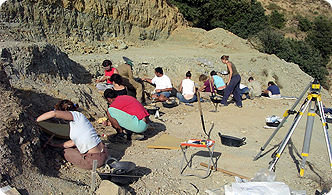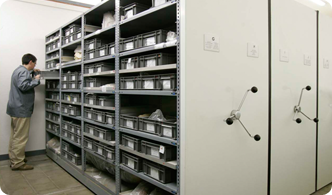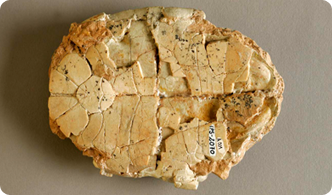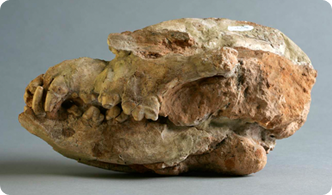The Institut Català de Paleontologia Miquel Crusafont carries out all the stages of paleontology from the finding, excavation and preparation of a fossil to its conservation, study and publication of results in scientific magazines and on through to its exposure in the mass media, exhibitions and museums.
What is a fossil?
Fossils are the remains of a living thing or its biological activity covered by sediments that with time have been compacted and hardened, making its conservation possible until the present time.

And what is paleontology?
Paleontology is the science of the study of living things of the past, and includes studying fossils.

Searching for fossils
The finding of a fossil can be done in two ways; by chance or after studying the geologic maps. If, for example, we search for dinosaur eggs or a skeleton of an Iguanodon, it is necessary to look in the layers of the era in which the dinosaurs lived; in this case the Mesozoic, between 251 and 65 million years ago. On the other hand, if what we want to find are fossils of anthropomorphous and others primates near the evolutionary line of man, it will be necessary to search in more recent sediments, of less than 15 million years from the Middle Miocene to the present time.

ICP paleontologists carry out the planning and prospecting of new lands suspected of yielding deposits of important fossils. Nevertheless, during spring and summer, they are usually dedicated to excavating in already well-known deposits, where new fossils are continuously found. Chance can also be an important factor in finding fossils. While hiking in the mountains, for example, some fortuitous finding can occur. For this reason, the ICP collaborates and receives the help of organizations like hiking centers.
Excavation

Once they have located and defined a fossil, the paleontologists of the ICP evaluate its state of conservation. It is also important to write down the position and the location in which the fossil appears. This information can be valuable for later studies. A paleontological excavation is an irreversible process because later we will not be able to put fossils back into the sediment as they were.Writing down these data correctly helps to virtually and accurately reconstruct the original distribution of fossils in the deposit in the future.
For taking measurements, the paleontologists use grids, tape measures, computers and a tool known as 'station' that allows them to establish the coordinates of a point and to know its location. On the other hand, shovels, pneumatic hammers, escarpments and bistouries are also used for excavation.
Initial preparation of fossils

In this way, when the time comes to transport it to the warehouses of the Institut, the material will not be damaged. The polyurethane, in addition, is a suitable material because it is very light and it does not add weight to the fossil, as is the case with plaster.
Transport

The circumstances of the deposits vary and the transport of fossils to the Institut depends on where they have been found. If they have appeared in an isolated location, the transport is difficult. 'Mummies' of moderate dimensions are transported in vans or vehicles. In exceptional cases, trucks and helicopters have also been used.
Arrival at the warehouse

The fossils arrive labeled from the excavations in such a way that the conservators of the ICP know at any moment what fossil is contained in the 'mummy'. The conservators are in charge of storing each fossil in an optimal way until it is time to take them to the preparation laboratory.
According to the priorities and capacity of the ICP at a given moment, the researchers decide what it has to prepare. At the appropriate moment, fossils are sent to the laboratory and the restorers clean the fossil so that later the investigators can study its characteristics.
That is to say, they release them from the 'mummy' and they also consolidate the fossil and, in some cases, they make casts to study or exhibit it.
Study


Once prepared, the fossil can now be manipulated by the researcher, who will be in charge of describing it and cataloging it.
In this way it will be possible to determine if the fossil belongs to a group, sort or described species, or if the fossil that has appeared is unknown, as in the case of Pierolapithecus catalaunicus, more commonly known as 'Pau'.
The study of the fossil can go on for weeks, months or years, depending on its complexity and classification. Starting with the existing bibliography, the researchers of the ICP also use the comparison with other skeletons or existing casts in the ICP or other centers.
This is known as 'material fossil of comparison'. If it is necessary, the researchers travel to other countries to learn more fully about the characteristics of the fossils. Later, drawings are usually made, although today they are also scanned in order to make use of virtual paleontology to reconstruct them with the aid of the computers and to work with its structure in 3D.
The results
Once the paleontologists have determined what fossil has been studied and what new contributions can be made for the improvement of knowledge in this discipline, they decide to publish the results in order to share them with the rest of the scientific community. In this way a scientific debate can be generated.
There are many specialized publications; Nature, Science, Brain Behaviour and Evolution, Journal of Human Evolution, American Journal of Physical Anthropology or Journal of Vertebrate Paleontology. These are just some of the most prestigious publications, but there are many more that are dedicated to specific areas.
The publication of an article in an important magazine is a long process since various verifications occur on the part of other experts who make critical revisions. Therefore, the time it takes the paleontologists to write the papers to the time they receive confirmation that it will be published can take at least six months.
The findings made by the researchers of the ICP have always been published in the best specialized magazines and have made remarkable contributions to the scientific debate.
Diffusion
Thus, paleontology reaches all those that are interested in it and the knowledge and the studies of the paleontologists of the Institut reach society. The circle is closed, but it is time to begin again because the researchers once again start new campaigns and discover new fossils.








